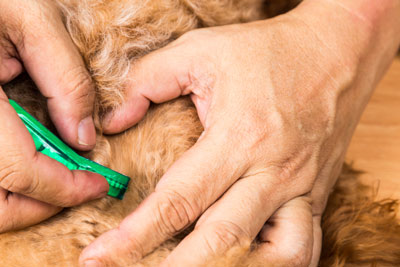How to Apply Topical Flea Medications to Dogs

Many flea and tick preventatives for dogs come in topical form. That means that you will need to apply the liquid to your dog's skin periodically, usually once a month.
Below is the technique to follow when applying these types of medications to your dog.
Never apply any medication to your dog, even a topical one, unless it was prescribed or recommended by your veterinarian. Never use a dog formulation on a cat.
Steps for Applying Topical Medications to Your Dog
When you are putting a topical liquid medication on your dog, these are the general steps to follow and things to keep in mind:
- Your dog will need to be still while you are applying the medication. It's often helpful to have a second person available to gently restrain your dog or distract him with treats while you put the medicine on him.
- The area between the shoulder blades, near the base of the skull, is usually a good place to put topical medications because it's a challenging spot for a dog to reach with his tongue. We don't want him ingesting the medicine.
- Hold the medicine applicator up and snap the tip off as directed.
- Use your non-dominant hand to find the spot in which you want to apply the liquid, and part the hair until you can clearly see the skin.
- Place the applicator as close to the skin as you can, upside down, and squeeze the applicator until all of the liquid has come out of the tube.
- DO NOT RUB THE MEDICATION IN. This action wicks the liquid onto the hair, and it doesn't work there. It must be absorbed into the skin to be effective.
- Let go of the hair and play with your dog for a bit or give him a meal to distract him while the medication absorbs and disperses. You may wish to wear gloves while applying or wash your hands when you are done.
If you are still not confident about applying the medication, you can ask your veterinarian's office if you could bring a dose in with your pet and be shown how to do it by a staff member.
You May Also Like These Articles:
Dog Fleas: How to Look for Fleas on Your Dog
Tips for Finding Fleas on Your Dog: VIDEO from VetVid
Bubonic Plague: The Role of Dogs in the Spread of Plague
Disclaimer: This website is not intended to replace professional consultation, diagnosis, or treatment by a licensed veterinarian. If you require any veterinary related advice, contact your veterinarian promptly. Information at DogHealth.com is exclusively of a general reference nature. Do not disregard veterinary advice or delay treatment as a result of accessing information at this site. Just Answer is an external service not affiliated with DogHealth.com.
Notice: Ask-a-Vet is an affiliated service for those who wish to speak with a veterinary professional about their pet's specific condition. Initially, a bot will ask questions to determine the general nature of your concern. Then, you will be transferred to a human. There is a charge for the service if you choose to connect to a veterinarian. Ask-a-Vet is not manned by the staff or owners of DogHealth.com, and the advice given should not delay or replace a visit to your veterinarian.



